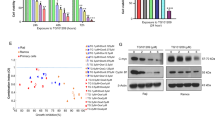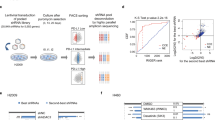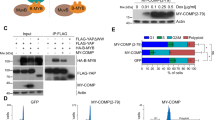Abstract
The activating protein-1 transcription factor, in particular the Jun proteins play critical roles in the regulation of cell proliferation and tumor progression. To study the potential clinical relevance of interfering with JunB expression, we generated retroviruses expressing short hairpin RNA. Reduction of JunB levels causes increased proliferation and tumorigenicity in wild-type murine fibroblasts, whereas in c-Jun knockout cells p53-independent cell cycle arrest and apoptosis are induced. Using melanoma-derived B16-F10 cancer cells the combination of JunB knockdown and c-Jun/JNK inactivation leads to cell cycle arrest and apoptosis-inducing factor-dependent apoptosis. Furthermore, the combined treatment extends survival of mice inoculated with the tumor cells. These results indicate that in the absence of c-Jun, JunB can act as a tumor promoter and inactivation of both, c-Jun and JunB, could provide a valuable strategy for antitumor intervention.
This is a preview of subscription content, access via your institution
Access options
Subscribe to this journal
Receive 50 print issues and online access
$259.00 per year
only $5.18 per issue
Buy this article
- Purchase on Springer Link
- Instant access to full article PDF
Prices may be subject to local taxes which are calculated during checkout







Similar content being viewed by others
Accession codes
References
Artus C, Maquarre E, Moubarak RS, Delettre C, Jasmin C, Susin SA et al. (2006). CD44 ligation induces caspase-independent cell death via a novel calpain/AIF pathway in human erythroleukemia cells. Oncogene 25: 5741–5751.
Bain J, McLauchlan H, Elliott M, Cohen P . (2003). The specificities of protein kinase inhibitors: an update. Biochem J 371: 199–204.
Bennett BL, Sasaki DT, Murray BW, O'Leary EC, Sakata ST, Xu W et al. (2001). SP600125, an anthrapyrazolone inhibitor of Jun N-terminal kinase. Proc Natl Acad Sci USA 98: 13681–13686.
Bohmann D, Bos TJ, Admon A, Nishimura T, Vogt PK, Tjian R . (1987). Human proto-oncogene c-jun encodes a DNA binding protein with structural and functional properties of transcription factor AP-1. Science 238: 1386–1392.
Bowden GT, Schneider B, Domann R, Kulesz-Martin M . (1994). Oncogene activation and tumor suppressor gene inactivation during multistage mouse skin carcinogenesis. Cancer Res 54: 1882s–1885s.
Brummelkamp TR, Bernards R, Agami R . (2002). Stable suppression of tumorigenicity by virus-mediated RNA interference. Cancer Cell 2: 243–247.
Chiu R, Angel P, Karin M . (1989). Jun-B differs in its biological properties from, and is a negative regulator of, c-Jun. Cell 59: 979–986.
Choi BY, Choi HS, Ko K, Cho YY, Zhu F, Kang BS et al. (2005). The tumor suppressor p16(INK4a) prevents cell transformation through inhibition of c-Jun phosphorylation and AP-1 activity. Nat Struct Mol Biol 12: 699–707.
Curran T, Peters G, Van Beveren C, Teich NM, Verma IM . (1982). FBJ murine osteosarcoma virus: identification and molecular cloning of biologically active proviral DNA. J Virol 44: 674–682.
Curran T, Teich NM . (1982). Candidate product of the FBJ murine osteosarcoma virus oncogene: characterization of a 55,000-dalton phosphoprotein. J Virol 42: 114–122.
Deng T, Karin M . (1993). JunB differs from c-Jun in its DNA-binding and dimerization domains, and represses c-Jun by formation of inactive heterodimers. Genes Dev 7: 479–490.
Eferl R, Ricci R, Kenner L, Zenz R, David JP, Rath M et al. (2003). Liver tumor development. c-Jun antagonizes the proapoptotic activity of p53. Cell 112: 181–192.
Eferl R, Wagner EF . (2003). AP-1: a double-edged sword in tumorigenesis. Nat Rev Cancer 3: 859–868.
Ennis BW, Fultz KE, Smith KA, Westwick JK, Zhu D, Boluro-Ajayi M et al. (2005). Inhibition of tumor growth, angiogenesis, and tumor cell proliferation by a small molecule inhibitor of c-Jun N-terminal kinase. J Pharmacol Exp Ther 313: 325–332.
Galluzzi L, Larochette N, Zamzami N, Kroemer G . (2006). Mitochondria as therapeutic targets for cancer chemotherapy. Oncogene 25: 4812–4830.
Gururajan M, Chui R, Karuppannan AK, Ke J, Jennings CD, Bondada S . (2005). c-Jun N-terminal kinase (JNK) is required for survival and proliferation of B-lymphoma cells. Blood 106: 1382–1391.
Gurzov EN, Izquierdo M . (2006). RNA interference against Hec1 inhibits tumor growth in vivo. Gene Therapy 13: 1–7.
Joseloff E, Bowden GT . (1997). Regulation of the transcription factor AP-1 in benign and malignant mouse keratinocyte cells. Mol Carcinog 18: 26–36.
Kang YH, Yi MJ, Kim MJ, Park MT, Bae S, Kang CM et al. (2004). Caspase-independent cell death by arsenic trioxide in human cervical cancer cells: reactive oxygen species-mediated poly(ADP-ribose) polymerase-1 activation signals apoptosis-inducing factor release from mitochondria. Cancer Res 64: 8960–8967.
Libermann TA, Zerbini LF . (2006). Targeting transcription factors for cancer gene therapy. Curr Gene Ther 6: 17–33.
Lopez-Bergami P, Huang C, Goydos JS, Yip D, Bar-Eli M, Herlyn M et al. (2007). Rewired ERK-JNK signaling pathways in melanoma. Cancer Cell 11: 447–460.
Mao X, Orchard G, Lillington DM, Russell-Jones R, Young BD, Whittaker SJ . (2003). Amplification and overexpression of JUNB is associated with primary cutaneous T-cell lymphomas. Blood 101: 1513–1519.
Marchetti P, Hirsch T, Zamzami N, Castedo M, Decaudin D, Susin SA et al. (1996). Mitochondrial permeability transition triggers lymphocyte apoptosis. J Immunol 157: 4830–4836.
Mariani O, Brennetot C, Coindre JM, Gruel N, Ganem C, Delattre O et al. (2007). JUN oncogene amplification and overexpression block adipocytic differentiation in highly aggressive sarcomas. Cancer Cell 11: 361–374.
Mingo-Sion AM, Marietta PM, Koller E, Wolf DM, Van Den Berg CL . (2004). Inhibition of JNK reduces G2/M transit independent of p53, leading to endoreduplication, decreased proliferation, and apoptosis in breast cancer cells. Oncogene 23: 596–604.
Nateri AS, Spencer-Dene B, Behrens A . (2005). Interaction of phosphorylated c-Jun with TCF4 regulates intestinal cancer development. Nature 437: 281–285.
Passegue B, Jochum W, Schorpp-Kistner M, Mohle-Steinlein U, Wargger EF . (2001). Chronic myeloid leukemia with increased granulocyte progenitors in mice lacking JunB expression in the myeloid lineage. Cell 104: 21–32.
Passegue E, Jochum W, Behrens A, Ricci R, Wagner EF . (2002). JunB can substitute for Jun in mouse development and cell proliferation. Nat Genet 30: 158–166.
Passegue E, Wagner EF, Weissman IL . (2004). JunB deficiency leads to a myeloproliferative disorder arising from hematopoietic stem cells. Cell 119: 431–443.
Rassidakis GZ, Thomaides A, Atwell C, Ford R, Jones D, Claret FX et al. (2005). JunB expression is a common feature of CD30+ lymphomas and lymphomatoid papulosis. Mod Pathol 18: 1365–1370.
Rauscher III FJ, Sambucetti LC, Curran T, Distel RJ, Spiegelman BM . (1988). Common DNA binding site for Fos protein complexes and transcription factor AP-1. Cell 52: 471–480.
Schreiber M, Kolbus A, Piu F, Szabowski A, Mohle-Steinlein U, Tian J et al. (1999). Control of cell cycle progression by c-Jun is p53 dependent. Genes Dev 13: 607–619.
Susin SA, Lorenzo HK, Zamzami N, Marzo I, Snow BE, Brothers GM et al. (1999). Molecular characterization of mitochondrial apoptosis-inducing factor. Nature 397: 441–446.
Szremska AP, Kenner L, Weisz E, Ott RG, Passegue E, Artwohl M et al. (2003). JunB inhibits proliferation and transformation in B-lymphoid cells. Blood 102: 4159–4165.
Vleugel MM, Greijer AE, Bos R, van der Wall E, van Diest PJ . (2006). c-Jun activation is associated with proliferation and angiogenesis in invasive breast cancer. Hum Pathol 37: 668–674.
Vogt PK . (2002). Fortuitous convergences: the beginnings of JUN. Nat Rev Cancer 2: 465–469.
Xia HH, He H, Wang JD, Gu Q, Lin MC, Zou B et al. (2006). Induction of apoptosis and cell cycle arrest by a specific c-Jun NH(2)-terminal kinase (JNK) inhibitor, SP-600125, in gastrointestinal cancers. Cancer Lett 241: 268–274.
Yang MY, Liu TC, Chang JG, Lin PM, Lin SF . (2003). JunB gene expression is inactivated by methylation in chronic myeloid leukemia. Blood 101: 3205–3211.
Yu SW, Wang H, Poitras MF, Coombs C, Bowers WJ, Federoff HJ et al. (2002). Mediation of poly(ADP-ribose) polymerase-1-dependent cell death by apoptosis-inducing factor. Science 297: 259–263.
Zenz R, Wagner EF . (2006). Jun signalling in the epidermis: from developmental defects to psoriasis and skin tumors. Int J Biochem Cell Biol 38: 1043–1049.
Zhang W, Hart J, McLeod HL, Wang HL . (2005). Differential expression of the AP-1 transcription factor family members in human colorectal epithelial and neuroendocrine neoplasms. Am J Clin Pathol 124: 11–19.
Acknowledgements
This study was supported by a grant from the ‘Fundación de investigación médica Mutua Madrileña Automovilística’ FMMA, Madrid, Spain. The Centro de Biología Molecular SO is the recipient of an institutional grant from the Ramón Areces Foundation and EN Gurzov was supported by a grant from the Comunidad Autónoma de Madrid-España. The IMP is funded by Boehringer Ingelheim.
Author information
Authors and Affiliations
Corresponding author
Additional information
Supplementary Information accompanies the paper on the Oncogene website (http://www.nature.com/onc).
Rights and permissions
About this article
Cite this article
Gurzov, E., Bakiri, L., Alfaro, J. et al. Targeting c-Jun and JunB proteins as potential anticancer cell therapy. Oncogene 27, 641–652 (2008). https://doi.org/10.1038/sj.onc.1210690
Received:
Revised:
Accepted:
Published:
Issue Date:
DOI: https://doi.org/10.1038/sj.onc.1210690
Keywords
This article is cited by
-
Integration of single-cell sequencing and bulk expression data reveals chemokine signaling pathway in proliferating cells is associated with the survival outcome of osteosarcoma
BMC Medical Genomics (2023)
-
Long non-coding RNA LINC00858 exerts a tumor-promoting role in colon cancer via HNF4α and WNK2 regulation
Cellular Oncology (2020)
-
Phosphoprotein patterns predict trametinib responsiveness and optimal trametinib sensitisation strategies in melanoma
Cell Death & Differentiation (2019)
-
MicroRNA-203 suppresses proliferation in liver cancer associated with PIK3CA, p38 MAPK, c-Jun, and GSK3 signaling
Molecular and Cellular Biochemistry (2018)
-
JUN dependency in distinct early and late BRAF inhibition adaptation states of melanoma
Cell Discovery (2016)



